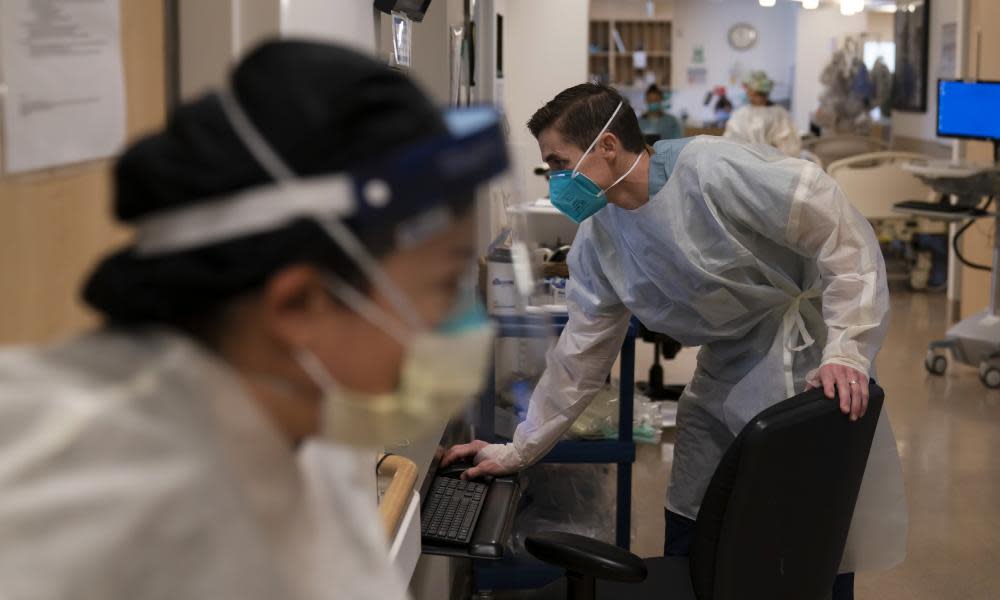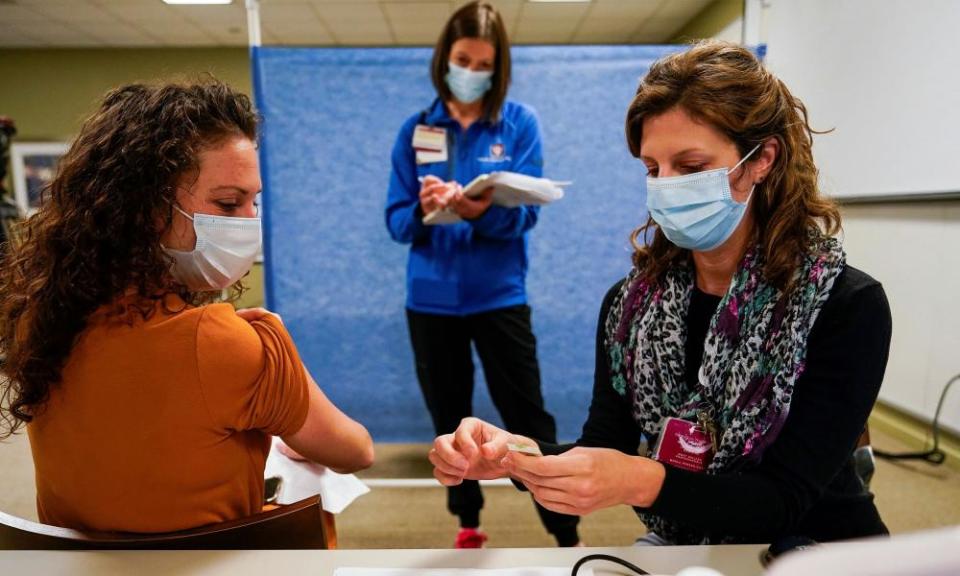'There are many roadblocks': Fears grow over US Covid-19 vaccine rollout

Eleven hospitals in Kentucky will receive doses of a Covid-19 vaccine developed by Pfizer, perhaps as soon as Monday. Dr Nichelle Jadhav’s hospital is not one of them and she is confused. And she is not alone.
Saint Joseph hospital, where Jadhav works, includes a 433-bed facility in the state’s second largest city of Lexington, which regularly takes transfers of seriously ill Covid-19 patients.
“Working at a large referral center for Kentucky and seeing smaller hospitals on the list – I really don’t have an explanation for why those selections were made,” Jadhav said. “We all are confused about how those 11 hospitals were selected.”
Related: FDA chief assures Americans of Covid vaccine safety after Pfizer authorization
The news crushed staff morale, said Jadhav. Doctors and nurses have watched one colleague after another fall ill with Covid-19 in recent months, and had pinned hopes for a brighter future on receipt of early vaccine doses.
“Obviously, we all understand everybody can’t get it all at once,” said Jadhav. But, without information on how the decisions were made, the team felt abandoned. “I don’t think anybody knew outside of the state government that it was only going to go to 11 hospitals, or where they were going.”
Jadhav’s experience is one likely being replicated across the country, as states begin distributing a vaccine with plans that vary widely, lack federal funding, are often opaque and will not reach everyone even in early, limited populations.
The US Food and Drug Administration (FDA) on Friday evening authorized a vaccine for emergency use, with the manufacturing partnership of pharmaceutical companies Pfizer and BioNTech expected to begin an initial shipment of 2.9m doses hours later.
White House officials have said Americans could begin seeing people get vaccinated as soon as Monday or Tuesday.
“The optimist in me wants to believe and hope that the largest mass vaccination program in the history of medicine will proceed without a hitch,” said Howard Markel, a professor at the University of Michigan school of public health. “The realist in me is seeing many, many, many roadblocks to that goal.”
The first vaccine allotments are expected to go to 21 million healthcare workers and 3 million residents of long-term care homes. But states have wide discretion about precisely how to distribute the vaccines, and will be challenged by a vaccine that has severe storage requirements – it must be kept at -70C (-94F) – and a lack of funding as a result of a congressional impasse on new federal funding.
Those challenges hold the potential to repeat mistakes made in testing by failing to meet the scale of the pandemic and rebuild the public trust necessary to contain the pandemic, even as the vaccine’s authorization was heralded by experts as an “extraordinary” achievement.
“This is not just coordination between authorities, healthcare professionals, healthcare systems,” said Dr Bruce Y Lee, a professor at the City University of New York School of Public Health. “Clinics and the general population need to understand these things, because if something goes off it will throw off the whole system.”
That does not mean success is impossible – any unprecedented campaign will have kinks, which still have the potential to be ironed out. General Gus Perna, the chief operating officer of the federal government’s vaccine development initiative called Operation Warp Speed, acknowledged as much on Saturday.
“We are not taking a victory lap,” said Perna. “We know the road ahead of us will be tough, we know situations will occur, but we will figure it out together, collectively, a whole of America approach to solve the problems.”
But plans are likely to be disparate and wide variation in who will receive the vaccine first is already showing up in states’ public announcements.

Kentucky will send two-thirds of its first vaccine allocation to long-term care facilities, where 65% of the state’s deaths have occurred. Compare that to New York state, which has also suffered huge loss of life in nursing homes, but promised “staff at every hospital in New York state … will have access to the first allocation of a vaccine”.
In Ohio, 88,000 of the state’s 98,000 doses will go to long-term care homes. In Colorado, the governor has said inmates will not be prioritized over people older than 65, even though the state’s distribution plan plainly called for the incarcerated, who have been hit extremely hard by Covid-19, to be ahead of older residents.
Exacerbating challenges, the federal government has decided to distribute the vaccine based on a state’s total population, rather than their population of high-risk groups, which could lead to surpluses in some states and deficits in others.
This is all in the face of the need for never-before-achieved adult vaccine coverage necessary to “extinguish” the pandemic, on the order of 80% coverage or higher, Lee and co-authors found in a recent paper published in the American Journal of Preventive Medicine. The target is far more ambitious than any immunization level ever accomplished in seasonal flu vaccinations campaigns, which generally hover around 50% coverage.
“If you really want to stop this dead in its tracks, there are 300 million people or so – you need to immunize every man, woman and child,” said Markel. “That means you need 656m doses.”
Challenges are likely to be amplified by some characteristics of the vaccines. Pfizer’s vaccine will almost certainly be labeled for use only in children older than 16 for at least several months, there is only short-term data on the duration of immunity provoked by the vaccine, and a lack of data on whether the vaccine also prevents transmission of the coronavirus.
In order to bring an out of control pandemic to heel, experts said, systems must work together. Americans must continue to wear masks, social distance, wash hands and avoid crowds while testing and contact tracing continues. In other words, it will take time – probably until the spring or summer of 2021 – to reach the levels of vaccination for which experts hope.
“It’s like telling a football team – you’re running out to play the Super Bowl – and the coach says, ‘Don’t worry, we have a gameplan,’” said Lee. If you don’t share that plan, it won’t help, he said. “Having a gameplan is not enough.”

